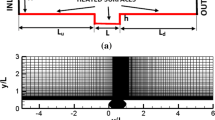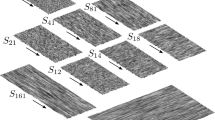Abstract
Detailed Laser Doppler velocimeter (LDV) measurements have been carried out in a turbulent rectangular channel flow with one rough wall. The roughness elements of two-dimensional spanwise 120° V-shaped grooves are periodically arranged with different depths and pitches. The Reynolds number based on the centerline velocity, and the channel half height ranges from 2,740 to 20,000. The comparisons of turbulence statistics over smooth and rough walls indicate that the present roughness leads to a significant change in the turbulence both in the inner and in the outer flow. Particularly, the distribution density of the grooves is a key parameter to evaluate the effect of roughness. The low-Reynolds-number dependence of turbulence statistics is also observed. The rough walls with the same pitch-to-depth ratio exhibit the equivalent roughness function under the corresponding Reynolds numbers. The disagreement of velocity defect profiles between smooth and rough walls challenges the defect universal law. The variations of the turbulence stresses and Reynolds shear stress decomposition in the outer layer suggest that the turbulent motions may be modified by the present grooves. The importance of sweep events for the present groove-roughened walls is reflected by the differences in relative contribution to Reynolds shear stress from each quadrant and the higher-order moments over smooth and rough walls.












Similar content being viewed by others
References
Abe H, Kawamura H, Matsuo Y (2001) Direct numerical simulation of a fully developed turbulent channel flow with respect to the Reynolds number dependence. J Fluids Eng-Trans ASME 123(6):382–393
Akinlade OG, Bergstrom DJ, Tachie MF, Castillo L (2004) Outer flow scaling of smooth and rough wall turbulent boundary layers. Exp Fluids 37(4):604–612
Amir M, Castro IP (2011) Turbulence in rough-wall boundary layers: universality issues. Exp Fluids. doi:10.1007/s00348-011-1049-7
Antonia RA, Krogstad PA (2001) Turbulence structure in boundary layers over different types of surface roughness. Fluid Dyn Res 28(2):139–157
Ashrafian A, Andersson HI, Manhart M (2004) DNS of turbulent flow in a rod-roughened channel. Int J Heat Fluid Flow 25(3):373–383
Bakken OM, Krogstad PA, Ashrafian A, Andersson HI (2005) Reynolds number effects in the outer layer of the turbulent flow in a channel with rough walls. Phys Fluids 17(6):065101-1-16
Bandyopadhyay P, Watson R (1988) Structure of rough-wall turbulent boundary layers. Phys Fluids 31(7):1877–1883
Bergstrom DJ, Kotey NA, Tachie MF (2002) The effects of surface roughness on the mean velocity profile in a turbulent boundary layer. J Fluid Eng-Trans ASME 124(3):664–670
Bhaganagar K, Kim J, Coleman G (2004) Effect of roughness on wall-bounded turbulence. Flow Turbul Combust 72(2):463–492
Burattini P, Leonardi S, Orlandi P, Antonia RA (2008) Comparison between experiments and direct numerical simulations in a channel flow with roughness on one wall. J Fluid Mech 600:403–426
Cal RB, Brzek B, Johansson TG, Castillo L (2009) The rough favourable pressure gradient turbulent boundary layer. J Fluid Mech 641:129–155
Clauser FH (1954) Turbulent boundary layers in adverse pressure gradients. AIAA J 21(2):91–108
Coleman HW, Steele WG (2009) Experimentation, validation, and uncertainty analysis for engineers, 3rd edn. Wiley, New Jersey
Connelly J, Schultz M, Flack K (2006) Velocity-defect scaling for turbulent boundary layers with a range of relative roughness. Exp Fluids 40(2):188–195
Cui J, Patel VC, Lin CL (2003) Large-eddy simulation of turbulent flow in a channel with rib roughness. Int J Heat Fluid Flow 24(3):372–388
Djenidi L, Elavarasan R, Antonia RA (1999) The turbulent boundary layer over transverse square cavities. J Fluid Mech 395:271–294
Djenidi L, Antonia RA, Amielh M, Anselmet F (2008) A turbulent boundary layer over a two-dimensional rough wall. Exp Fluids 44(1):37–47
Durst F, Fischer M, Jovanovic J, Kikura H (1998) Methods to set up and investigate low Reynolds number, fully developed turbulent plane channel flows. J Fluids Eng-Trans ASME 120(9):496–503
Eiamsa-ard S, Promvonge P (2009) Thermal characteristics of turbulent rib-grooved channel flows. Int Commun Heat Mass Transf 36(7):705–711
Flack KA, Schultz MP, Shapiro TA (2005) Experimental support for Townsend’s Reynolds number similarity hypothesis on rough walls. Phys Fluids 17(3):035102-1-9
Han J, Brown BN, Nesic S (2010) Investigation of the galvanic mechanism for localized carbon dioxide corrosion propagation using the artificial pit technique. Corrosion 66(9):095003-1-12
Ikeda T, Durbin PA (2007) Direct simulations of a rough-wall channel flow. J Fluid Mech 571:235–263
Jiménez J (2004) Turbulent flows over rough walls. Annu Rev Fluid Mech 36(1):173–196
Keirsbulck L, Labraga L, Mazouz A, Tournier C (2002) Surface roughness effects on turbulent boundary layer structures. J Fluids Eng-Trans ASME 124(1):127–135
Krogstad PA, Antonia RA (1999) Surface roughness effects in turbulent boundary layers. Exp Fluids 27(5):450–460
Krogstad PA, Antonia RA, Browne LW (1992) Comparison between rough-wall and smooth-wall turbulent boundary-layers. J Fluid Mech 245:599–617
Krogstad PA, Andersson HI, Bakken OM, Ashrafian A (2005) An experimental and numerical study of channel flow with rough walls. J Fluid Mech 530:327–352
Lee SH, Sung HJ (2007) Direct numerical simulation of the turbulent boundary layer over a rod-roughened wall. J Fluid Mech 584:125–146
Lee SH, Kim JH, Sung HJ (2008) PIV measurements of turbulent boundary layer over a rod-roughened wall. Int J Heat Fluid Flow 29(6):1679–1687
Lee JH, Lee SH, Kim K, Sung HJ (2009) Structure of the turbulent boundary layer over a rod-roughened wall. Int J Heat Fluid Flow 30(6):1087–1098
Leonardi S, Orlandi P, Smalley RJ, Djenidi L, Antonia RA (2003) Direct numerical simulations of turbulent channel flow with transverse square bars on one wall. J Fluid Mech 491:229–238
Miyake Y, Tsujimoto K, Nakaji M (2001) Direct numerical simulation of rough-wall heat transfer in a turbulent channel flow. Int J Heat Fluid Flow 22(3):237–244
Miyake Y, Tsujimoto K, Nagai N (2002) Numerical simulation of channel flow with a rib-roughened wall. J Turbul 3:1–17
Moser RD, Kim J, Mansour NN (1999) Direct numerical simulation of turbulent channel flow up to Re τ = 590. Phys Fluids 11:943–945
Nagano Y, Hattori H, Houra T (2004) DNS of velocity and thermal fields in turbulent channel flow with transverse-rib roughness. Int J Heat Fluid Flow 25(3):393–403
Perry AE, Abell CJ (1977) Asymptotic similarity of turbulence structures in smooth- and rough-walled pipes. J Fluid Mech 79:785–799
Perry AE, Schofield WH, Joubert PN (1969) Rough-wall turbulent boundary layers. J Fluid Mech 37:383–413
Raupach MR, Antonia RA, Rajagopalan S (1991) Rough-wall turbulent boundary layers. Appl Mech Rev 44(1):1–25
Schmitt G, Bosch C, Mueller M (2000) A probabilistic model for flow induced localized corrosion. CORROSION/2000, NACE International, Houston, Tx. Paper No.00049
Schultz MP, Flack KA (2009) Turbulent boundary layers on a systematically varied rough wall. Phys Fluids 21:015104-1-9
Spalding DB (1961) A single formula for the law of the wall. J Appl Mech 28:455–458
Tachie MF, Bergstrom DJ, Balachandar R (2003) Roughness effects in low-Re-theta open-channel turbulent boundary layers. Exp Fluids 35(4):338–346
Townsend AA (1976) The structure of turbulent shear flow. Cambridge University Press, Cambridge
Vesely L, Haigermoser C, Greco D, Onorato M (2009) Turbulent flow and organized motions over a two-dimensional rough wall. Phys Fluids 21(12):125107-1-19
Volino RJ, Schultz MP, Flack KA (2009) Turbulence structure in a boundary layer with two-dimensional roughness. J Fluid Mech 635:75–101
Wallace JM, Eckelmann H, Brodkey RS (1972) The wall region in turbulent shear flow. J Fluid Mech 54(01):39–48
Wu Y, Christensen KT (2007) Outer-layer similarity in the presence of a practical rough-wall topography. Phys Fluids 19(8):85108–85115
Acknowledgments
The authors wish to thank Prof. P A Krogstad of Norwegian University of Science and Technology for his advice and discussion on turbulent channel flow. Prof. James M. Wallace from University of Maryland is gratefully acknowledged for his suggestions on the data processing and analysis when he was teaching the class of “Turbulence” in Xi’an Jiaotong University.
Author information
Authors and Affiliations
Corresponding author
Rights and permissions
About this article
Cite this article
Zhang, Y., Che, D. Effects of two-dimensional V-shaped grooves on turbulent channel flow. Exp Fluids 52, 315–328 (2012). https://doi.org/10.1007/s00348-011-1223-y
Received:
Revised:
Accepted:
Published:
Issue Date:
DOI: https://doi.org/10.1007/s00348-011-1223-y




